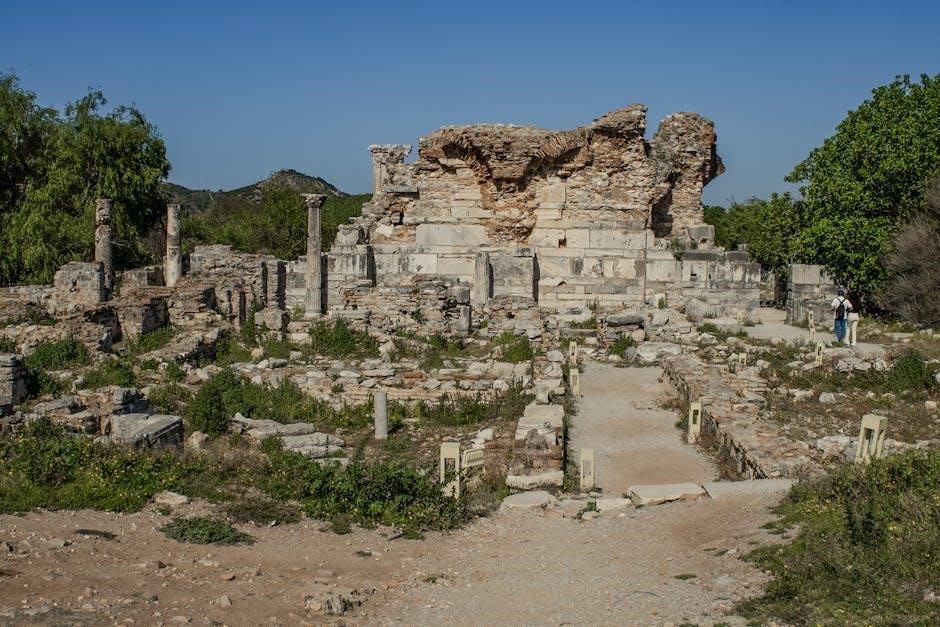The History of Mary Prince is a significant autobiographical account of a Black woman’s experiences in slavery, published in 1831. Edited by abolitionist Thomas Pringle, it includes a preface, Mary’s narrative, a supplement, and Asa-Asa’s story, exposing the brutality of slavery and advocating for abolition, making it a crucial historical document.
1.1 Overview of the Book
The History of Mary Prince is a pioneering autobiographical narrative published in 1831, edited by Scottish abolitionist Thomas Pringle. It recounts Mary Prince’s harrowing experiences as a enslaved woman in the Caribbean, detailing her early life, brutal treatment, and resilience. The book includes a preface by Pringle, Mary’s autobiographical account transcribed by Susanna Strickland Moodie, a supplement by Pringle defending her story, and the narrative of Asa-Asa, a captured African. This composite text exposes the atrocities of slavery, making it a powerful tool in the abolitionist movement and a significant historical document of the time.
1.2 Historical Context of Slavery in the Caribbean
The Caribbean during the 18th and 19th centuries was a hub of plantation slavery, driven by the demand for sugar, tobacco, and other crops. Enslaved Africans were forcibly brought to the region through the transatlantic slave trade, enduring brutal conditions on plantations. Slave codes governed their lives, denying basic rights and subjected them to harsh punishments. The system was economically vital to colonial powers but devastating for enslaved people, who faced physical and emotional trauma. Mary Prince’s narrative offers a personal lens into this broader history, highlighting the horrors of Caribbean slavery and its profound impact on individuals and communities.
1.3 Importance of Mary Prince’s Narrative
Mary Prince’s narrative holds immense historical and literary significance as one of the earliest autobiographies by a Black woman in the British Empire. It provides a firsthand account of Caribbean slavery, exposing its brutal realities to the British public. Her story influenced abolitionist movements, offering emotional and moral ammunition against slavery. By sharing her suffering and resilience, Prince humanized enslaved individuals, challenging stereotypes and advocating for freedom and justice. Her voice remains a powerful testament to the enduring impact of slavery and the struggle for human rights, making her narrative a vital piece of historical literature.

Early Life and Enslavement
Mary Prince was born into slavery in Bermuda, her mother a household slave, her father a sawyer. She was sold to Captain Darrell, facing early hardships and separation from her family, marking the start of her traumatic enslavement journey.
2.1 Birth and Family Background
Mary Prince was born around 1788 in Brackish-Pond, Devonshire Parish, Bermuda. Her mother, a household slave, was owned by the Darrell family. Mary’s father was a sawyer, also enslaved, though details about him are sparse. From birth, Mary was bound to a life of servitude, her status determined by her mother’s enslavement. This began her journey through the harsh realities of Caribbean slavery, shaping her early experiences and resilience.
2.2 Childhood Experiences in Bermuda
Mary Prince was born into slavery in Bermuda around 1788. Her mother was a household slave of the Darrell family. At a young age, Mary was purchased by Captain Williams, whose wife and daughter treated her relatively kindly. Despite this, her childhood was marked by the harsh realities of slavery, highlighting the contrasts of kindness within an oppressive system. These early experiences shaped her resilience and understanding of the injustices she would later fight against.
2.3 First Encounters with Slavery
Mary Prince’s early life in Bermuda exposed her to the brutal realities of slavery. After her mother’s owner died, she was sold to Captain Darrell, experiencing harsh conditions and forced labor. These encounters revealed the dehumanizing aspects of slavery, shaping her determination to resist oppression. Her narrative vividly captures the physical and emotional toll of these experiences, providing a powerful testament to the horrors endured by enslaved individuals.

Life Under Different Enslavers
Mary Prince endured harsh conditions under various enslavers, including Captain Darrell, the Williams family, and the Prudens. Each experience exposed her to varying degrees of cruelty and exploitation.
3.1 Captain Darrell and Early Hardships
Mary Prince’s early life under Captain Darrell was marked by severe hardship and exploitation. She was subjected to relentless labor, physical abuse, and emotional distress. Despite her young age, she was forced into grueling tasks, often without compassion. Captain Darrell’s cruelty set the tone for the brutal treatment she would endure under subsequent enslavers. These experiences deeply shaped her resilience and determination to seek freedom. Her narrative vividly captures the harrowing conditions faced by enslaved individuals, highlighting the inhumane nature of the slave system.
3.2 The Williams Family and Relative Kindness
Mary Prince’s time with the Williams family offered a rare respite from the brutality of slavery. Mrs. Williams, though still an enslaver, treated Mary with relative kindness and compassion. Mary formed a strong bond with the family, particularly with Miss Betsey, the daughter, and was deeply saddened when she was eventually sold. This period in her life highlights the contrasts within the slave system, where some enslavers showed humanity, while others inflicted relentless cruelty. Despite the kindness, Mary’s status as a slave remained unaltered, and she was ultimately sold again, enduring further hardship.
3.3 The Pruden Family and Increased Labor
Mary Prince’s experience with the Pruden family marked a shift towards harsher conditions and increased labor demands. She was tasked with caring for Mrs. Pruden’s children, a duty that, while domestic, was physically exhausting. The Prudens’ expectations were relentless, and Mary faced little respite from her duties. This period in her life underscores the exploitation inherent in slavery, where even seemingly less brutal environments still demanded relentless work. Despite the relative kindness of the Williams family, the Prudens’ demands highlighted the systemic nature of her oppression, as her value was solely measured by her labor output.
The Journey to Freedom
Mary Prince’s journey to freedom involved her conversion to Christianity, marriage to Daniel James, legal battles, and eventual escape to England, where she gained legal freedom, advocating against slavery.
4.1 Conversion to Christianity
Mary Prince’s conversion to Christianity marked a pivotal moment in her journey to freedom. During a Methodist prayer meeting in Antigua, she found solace in faith, which empowered her to resist oppression. Her spiritual awakening not only provided emotional strength but also connected her with a supportive community. This newfound faith became a cornerstone of her resistance, inspiring her to advocate for abolition and human rights, even as she faced continued exploitation by her enslavers.
4.2 Marriage and Legal Battles
Mary Prince’s marriage to Daniel James, a free Black man, symbolized her pursuit of freedom and dignity. Despite her legal status as a slave, the union provided emotional strength. However, her enslavers, the Woods, refused to recognize her freedom, leading to legal conflicts. With the support of the Anti-Slavery Society, Prince fought for her rights, highlighting the injustices of slavery. Her case drew attention to the contradictions in British law, where enslaved individuals in England were technically free, yet systemic oppression persisted. This period marked her growing activism and determination to challenge the legal boundaries of slavery.
4.4 Escape to England and Legal Freedom
Mary Prince’s journey to England marked a turning point in her quest for freedom. Upon arrival, she leveraged British law, which did not recognize slavery, to assert her rights. Despite her enslavers’ resistance, Prince sought refuge with abolitionists, including Thomas Pringle, who supported her legal battles. Her presence in England highlighted the contradictions in British slavery laws, ultimately leading to her recognition as a free woman. This chapter in her life underscores her resilience and the legal loopholes that enslaved individuals could exploit to gain freedom, inspiring broader abolitionist efforts and challenging the institution of slavery.
The Publication of the Narrative
The History of Mary Prince was published in 1831, edited by Thomas Pringle, with Susanna Moodie transcribing Mary’s account. It includes a preface, her narrative, a supplement by Pringle, and the Narrative of Asa-Asa, a Captured African.
5.1 Thomas Pringle’s Role as Editor
Thomas Pringle, a Scottish abolitionist, played a crucial role in publishing Mary Prince’s narrative. He edited and verified her account, ensuring its authenticity. Pringle also contributed a preface and a supplement, countering criticisms and advocating for abolition. His editorial work helped amplify Mary’s voice, making her story accessible to a broader audience and reinforcing its impact in the fight against slavery.
5.2 Susanna Strickland Moodie’s Transcription
Susanna Strickland Moodie transcribed Mary Prince’s oral account, preserving her harrowing experiences in written form. Moodie’s role was vital in conveying Mary’s voice accurately, ensuring her story’s emotional depth reached readers. Her transcription aligned with the abolitionist goals of Pringle, making Mary’s narrative a powerful tool against slavery, while also highlighting the collaborative effort behind the publication.
5.3 The Publishing Process in 1831
The History of Mary Prince was published in 1831 in England, edited by Thomas Pringle, a Scottish abolitionist. The narrative was transcribed from Mary’s oral account by Susanna Strickland Moodie, with Pringle ensuring its accuracy. The book included a preface, Mary’s autobiography, a supplement by Pringle defending her claims, and Asa-Asa’s story. Its publication aimed to expose the brutality of slavery and support the abolitionist movement; Despite its impact, the book faced legal challenges, particularly from Mr. Wood, who disputed Mary’s account. The proceeds from sales supported Mary, highlighting the collaborative effort to amplify her voice against slavery.
Structure and Content of the Book
The History of Mary Prince features a preface by Thomas Pringle, Mary’s autobiographical account, a supplement by Pringle, and Asa-Asa’s narrative, collectively exposing slavery’s horrors and advocating abolition.
6.1 Preface by Thomas Pringle
Thomas Pringle’s preface introduces Mary Prince’s narrative, highlighting her initiative to share her story. He outlines the editorial process, noting Susanna Strickland Moodie’s transcription and his own verification of details. Pringle emphasizes the narrative’s authenticity, ensuring it remains faithful to Mary’s oral account. He also mentions the inclusion of the Narrative of Asa-Asa, a Captured African, broadening the scope of the text. The preface serves as a bridge, connecting Mary’s personal testimony with the broader abolitionist movement, aiming to inform and persuade the British public about the injustices of slavery.
6.2 Mary Prince’s Autobiographical Account
Mary Prince’s autobiographical account vividly details her life from birth in Bermuda to her enslavement and eventual freedom. She recounts her early hardships, brutal treatment by various enslavers, and the physical and emotional toll of slavery. Her narrative also shares moments of resilience, such as her conversion to Christianity and marriage to Daniel James. The account is a poignant testimony, offering a firsthand perspective on the horrors of slavery and the strength of the human spirit. It remains a powerful voice in the fight against oppression and a crucial historical document.
6.3 Supplement by the Editor
The supplement, written by editor Thomas Pringle, provides additional context and advocacy for Mary Prince’s freedom. It includes letters from Mr. Wood, Mary’s former enslaver, which Pringle refutes with evidence and testimonies. Pringle highlights the injustices Mary faced and argues for the abolition of slavery. He also explains that proceeds from the book would support Mary financially. The supplement serves as a powerful critique of slavery, emphasizing the need for moral and legal change. It underscores Mary’s dignity and resilience while challenging societal attitudes toward enslaved people.
6.4 Narrative of Asa-Asa, a Captured African
The narrative of Asa-Asa, appended to Mary Prince’s account, shares the story of a West African man captured and enslaved. His journey details the horrors of the transatlantic slave trade, from captivity in Africa to liberation in England. Asa-Asa’s story complements Mary’s, providing a broader perspective on slavery’s impact. His personal loss and resilience highlight the universal suffering endured by enslaved individuals. The inclusion of his narrative strengthens the abolitionist message, offering a poignant reminder of the human cost of slavery and the moral imperative to end it. His voice adds depth to the collective struggle for freedom.

Themes and Messages
The History of Mary Prince explores themes of slavery’s brutality, the power of faith, and the relentless pursuit of freedom, highlighting the human spirit’s resilience against oppression.
7.1 The Horrors of Slavery
The History of Mary Prince vividly portrays the brutal realities of slavery, detailing physical abuse, emotional trauma, and the dehumanizing conditions endured by enslaved individuals. Mary recounts her personal suffering, including relentless labor, harsh punishments, and the anguish of being separated from her family. Her narrative exposes the cruelty of slave owners and the systemic exploitation inherent in the institution. The vivid descriptions of whippings, inadequate clothing, and meager food highlight the inhumane treatment of enslaved people, serving as a powerful indictment of slavery and a testament to the resilience of those who endured it.
7.2 The Power of Religion and Faith
Mary Prince’s narrative highlights the central role of religion and faith in her life as a source of strength and hope. During her enslavement, Mary found solace in Christianity, particularly after attending a Methodist prayer meeting. Her conversion to the Moravian Church provided emotional and spiritual resilience, helping her endure the harsh conditions of slavery. Faith became a means of resistance, offering her a sense of dignity and purpose. Her religious beliefs also influenced her advocacy for freedom, as she viewed her liberation as a divine right, further emphasizing the transformative power of faith in her journey.
7.3 The Fight for Freedom and Justice
Mary Prince’s narrative underscores her relentless pursuit of freedom and justice, despite the oppressive systems of slavery. Her escape to England and legal battles highlight her determination to challenge the status quo. Prince’s advocacy, supported by the Anti-Slavery Society, aimed to expose the injustices of slavery and push for abolition. Her story not only sought personal liberation but also inspired broader societal change, demonstrating the power of individual resistance in the fight against systemic oppression. Her courage and resilience remain a testament to the human spirit’s quest for freedom and equality.

Impact and Legacy
The History of Mary Prince significantly influenced the abolitionist movement, exposing the brutal realities of slavery and advocating for its end. Its publication raised public awareness, contributing to the eventual abolition of slavery in British colonies. Today, it remains a vital historical and educational resource, highlighting the enduring legacy of Mary Prince’s fight for freedom and justice.
8.1 Influence on the Abolitionist Movement
The History of Mary Prince played a pivotal role in the abolitionist movement by exposing the brutal realities of slavery. Published in 1831, it was one of the first slave narratives by a Black woman, providing a personal and harrowing account of life in bondage. The book, edited by Thomas Pringle, highlighted the moral urgency of ending slavery, influencing public opinion in Britain. Its vivid descriptions of suffering and resilience galvanized support for abolition, making it a key text in the fight against slavery. The narrative’s impact contributed to the eventual abolition of slavery in British colonies, cementing its legacy as a powerful tool for justice.
8.2 Reception in Britain and Beyond
The History of Mary Prince received significant attention in Britain upon its release, shocking readers with its vivid depiction of slavery’s brutality. The narrative resonated deeply, fueling abolitionist sentiments and prompting widespread debate. While praised for its authenticity, the book also faced criticism and challenges to its validity, with some questioning its accuracy. Despite this, it remained a powerful tool for abolitionists, influencing public opinion and contributing to the growing demand for emancipation. The narrative’s global reach extended beyond Britain, making it a pivotal text in the international fight against slavery and cementing its historical significance.
8.3 Modern Recognition and Relevance
The History of Mary Prince is celebrated today as a groundbreaking work in the genre of slave narratives, offering a rare female perspective on slavery. Its modern recognition includes its use in academic curricula, where it is studied for its historical and literary value. The narrative’s themes of resilience and the fight for justice continue to resonate, making it a vital resource for understanding the transatlantic slave trade. Additionally, its availability as a free PDF ensures accessibility, allowing new generations to engage with Mary Prince’s powerful story and appreciate its enduring relevance in contemporary discussions on race and human rights.

Related Works and Comparisons
The History of Mary Prince is often compared to Robert Wedderburn’s accounts, offering unique female perspectives on Caribbean slavery. It aligns with other slave narratives in its abolitionist intent but stands out for its personal, emotional depth and historical specificity.
9.1 Comparison with Robert Wedderburn’s Accounts
Mary Prince’s narrative shares similarities with Robert Wedderburn’s accounts in exposing Caribbean slavery’s brutality. Both authors, once enslaved, highlight the inhumane treatment and the fight for freedom. However, Prince’s work stands out as one of the first slave narratives by a Black woman, offering a unique female perspective. While Wedderburn’s accounts often emphasize political activism, Prince’s story focuses on personal suffering and resilience. Both works serve as powerful abolitionist tools, but Prince’s emotional depth and specificity about her experiences provide a distinct voice in the genre of slave narratives, making her account particularly impactful and historically significant.
9.2 Similarities with Other Slave Narratives
The History of Mary Prince aligns with other slave narratives in its depiction of brutality, resilience, and the quest for freedom. Like many such accounts, it details the dehumanizing conditions of slavery, including forced labor, physical abuse, and family separation. The narrative also emphasizes the psychological toll of enslavement and the role of religion as a source of strength. Prince’s story, however, uniquely highlights the experiences of a Black woman in the Caribbean, offering a distinct perspective within the broader genre. These similarities underscore the shared horrors of slavery while allowing Prince’s voice to stand out in its specificity and emotional depth.
9.3 The Unique Voice of Mary Prince
Mary Prince’s narrative stands out as one of the first autobiographies by a Black woman in the British Empire, offering a rare and personal account of Caribbean slavery. Her voice conveys raw emotion, detailing the harsh realities of her life, from childhood in Bermuda to her struggle for freedom in England. Unlike other slave narratives, Prince’s story is deeply personal, sharing intimate details of her relationships and inner strength. Her conversion to Christianity and marriage add unique layers to her journey, making her narrative a powerful testament to individual resilience and the broader fight against slavery. Her story remains a vital historical document, providing an unflinching look at the horrors of enslavement and the enduring human spirit.

Educational and Literary Significance
The History of Mary Prince is a vital resource for understanding the transatlantic slave trade and Caribbean slavery, included in academic curricula worldwide for its historical and literary value.
10.1 Use in Academic Curricula
The History of Mary Prince is widely used in academic curricula for its historical and literary significance, providing insights into Caribbean slavery and abolitionist movements. Study guides and resources, such as those from SuperSummary, offer detailed chapter analyses, themes, and character studies, aiding educators and students. The narrative’s inclusion in university courses highlights its value for discussing slavery, gender, and race. Its accessibility as a PDF ensures widespread use in classrooms, making it a vital tool for teaching critical thinking about historical and social justice issues.
10.2 Literary Analysis and Critical Reception
The History of Mary Prince has garnered significant literary attention for its raw, firsthand account of slavery. Critics praise its unflinching portrayal of the brutality and emotional toll of enslavement, while some analyze its role as a political tool in the abolitionist movement. The narrative’s authenticity, despite editorial influences, is a focal point of discussion. Scholars also explore its structure, blending personal testimony with abolitionist rhetoric, making it a unique yet powerful literary work. Its impact on 19th-century British abolitionist debates underscores its historical and literary importance, solidifying its place in academic and critical discourse.
10.3 Resources for Teaching and Learning
Educators and students can access various resources to engage with The History of Mary Prince. Study guides, such as those from SuperSummary, provide chapter-by-chapter analyses, themes, and critical essays. The full text is available for free on Documenting the American South, enabling easy access for classroom use. Additionally, discussion guides and lesson plans focus on slavery, abolition, and gender, helping to contextualize the narrative. These resources enhance understanding and facilitate deeper exploration of Mary Prince’s experiences, making her story accessible and meaningful for modern learners.
